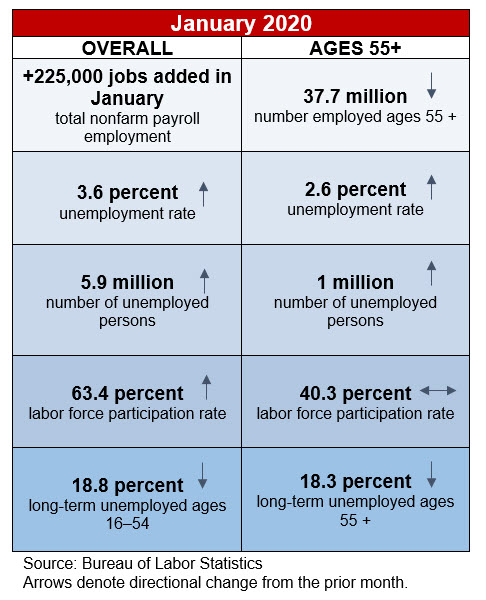AARP Hearing Center
Economy Adds 225,000 Jobs, 55+ Labor Force Participation Rate Unchanged for Sixth Month
By Jennifer Schramm, February 7, 2020 05:26 PM


Employment Overview
The economy added 225,000 jobs in January 2020, up from 147,000 jobs added in December (revised up from +145,000), according to the Bureau of Labor Statistics (BLS) monthly Employment Situation Summary. The overall unemployment rate edged up to 3.6 percent and to 2.6 percent for those ages 55 and older. The number of people ages 55+ who were unemployed increased to 1 million, while the number employed in this age group decreased slightly to 37.7 million. The overall labor force participation rate was up slightly to 63.4 percent and, for the sixth consecutive month, remained at 40.3 percent for those ages 55+. In January, 18.3 percent of jobseekers ages 55+ were long-term unemployed (i.e., looking for work for 27 weeks or longer) compared with 18.8 percent of those ages 16 to 54.
Spotlight on Unions and Older Workers
In January, the BLS released its 2019 data on union membership in the United States, which it collects annually as part of the Current Population Survey (CPS). The data showed that workers ages 45 to 64 are the most likely to belong to a labor union. In 2019, 12.6 percent of workers ages 45 to 54 and 12.7 percent of those ages 55 to 64 were union members. This compared with the 10.3 percent overall rate (a 0.2 percentage point decrease from 2018).
Though the number of wage and salary workers belonging to unions changed little from 2018, it stands in contrast to the union-membership levels reached in the 1980s, when many of today’s older union members were at the beginning of their working lives. The BLS noted that in 1983, the first year for which comparable union data are available, the union membership rate was 20.1 percent, and there were 17.7 million union workers in the United States. By 2019 that number had declined to 14.6 million.
Some of the declines in union membership rates may relate to shifts in employment within sectors and occupations. The union membership rate of public-sector workers remains more than five times higher in 2019 than the rate of private-sector workers with the highest unionization rates. In turn, the changes in union membership rates may have influenced other aspects of the labor market. For example, non-union workers tend to have lower wages – in 2019, median weekly earnings of non-union workers were 81 percent of earnings of workers who were union members – and the decline in union membership is, therefore, often cited as one of the factors behind slow or stagnant wage growth in recent decades.
Find more details on the latest employment data in the January Employment Data Digest, the AARP Public Policy Institute's (PPI) monthly review of job trends for those ages 55 and over. For more data to drive policy solutions, go to PPI's Data Explorer, and for information on skills, jobs, and occupations for the 50+, visit AARP's skills shortage data tool.
































































